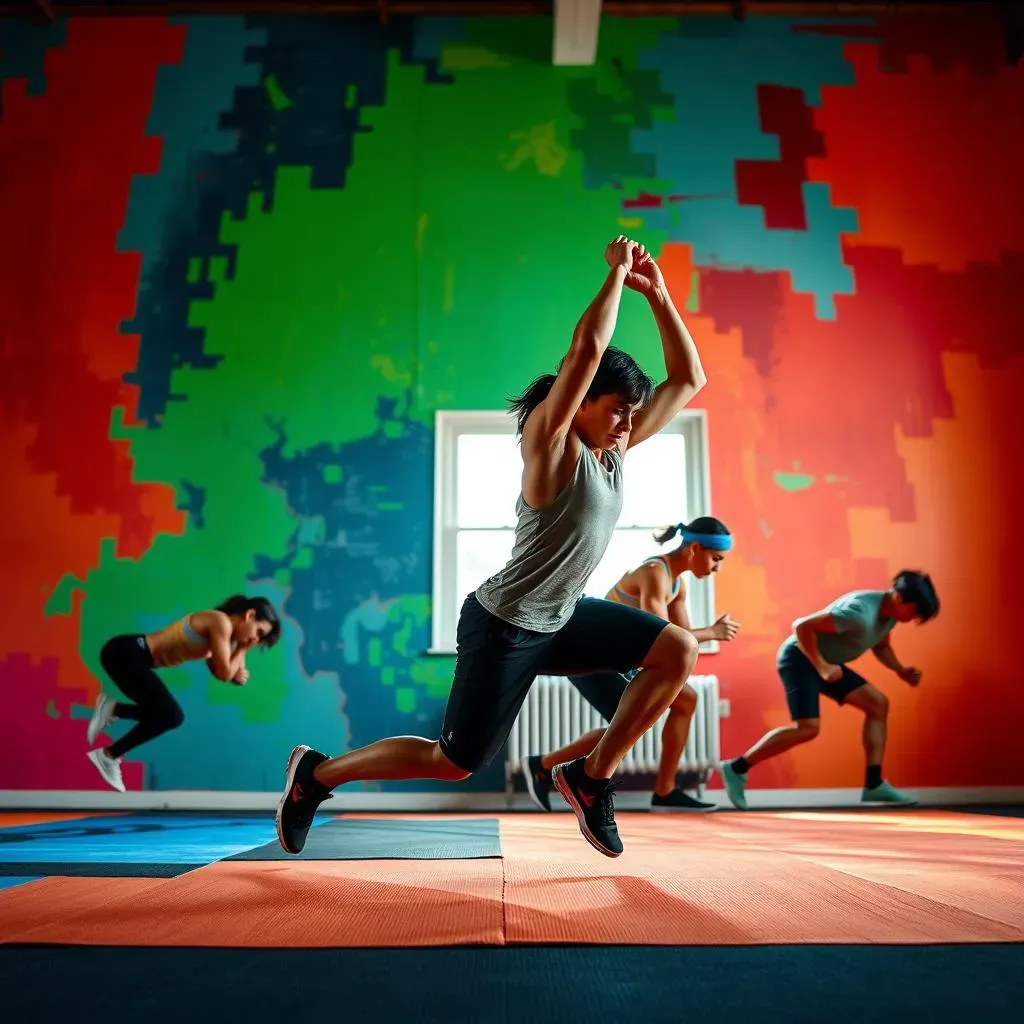Table of Contents
Are you wondering if calisthenics is a workout? The answer is a resounding yes! Calisthenics, also known as callisthenics, is a form of strength training that uses body weight as resistance to perform multi-joint, compound movements. This effective and accessible way to improve fitness and functional strength has gained popularity worldwide. With calisthenics, you can work out anywhere, anytime, without the need for expensive equipment or gym memberships. But what makes calisthenics such a powerful workout? In this article, we'll delve into the benefits, examples of exercises, and tips for beginners to help you understand why calisthenics is an excellent workout option. Whether you're a fitness enthusiast or just starting out, calisthenics can help you achieve significant gains in strength, agility, and overall well-being. So, let's explore the world of calisthenics and discover how this bodyweight training can transform your fitness journey.
What is Calisthenics and How Does it Work as a Workout?

What is Calisthenics and How Does it Work as a Workout?
Understanding Calisthenics: A Bodyweight Workout
Calisthenics is a form of exercise that uses body weight as resistance to build strength, flexibility, and coordination. It involves performing multi-joint movements that engage multiple muscle groups at once, such as push-ups, squats, and lunges. These exercises are designed to improve functional strength, which is essential for everyday activities and athletic performance. Unlike weightlifting, calisthenics doesn't require any equipment, making it accessible to anyone, anywhere. Whether you're a beginner or an experienced athlete, calisthenics can be modified to suit your fitness level, from basic movements to more advanced techniques.
The beauty of calisthenics lies in its simplicity and effectiveness. By using your own body weight, you can work out anywhere, whether at home, in a park, or during travel. This convenience factor makes it easier to stick to a workout routine, as you're not dependent on a gym or special equipment. Moreover, calisthenics helps improve balance, agility, and overall physical fitness, reducing the risk of injury compared to weightlifting. As you progress, you can increase the intensity by adding more complex movements, such as plyometrics or isometric holds.
Exercise | Muscles Worked | Benefits |
|---|---|---|
Push-ups | Chest, Shoulders, Triceps | Improves upper body strength |
Squats | Legs, Glutes, Core | Enhances lower body strength and balance |
Lunges | Legs, Glutes, Core | Improves coordination and overall lower body strength |
- Improved functional strength
- Increased flexibility and coordination
- Enhanced cardiovascular fitness
- Low risk of injury compared to weightlifting
How Calisthenics Works as a Workout
Calisthenics works by engaging multiple muscle groups simultaneously, which helps build strength, endurance, and agility. Each exercise targets specific muscle groups, but also requires engagement from secondary muscles to maintain proper form. For example, a squat not only works the legs but also requires core engagement to maintain balance. This holistic approach to exercise helps develop functional strength that translates to real-life activities and sports.
Another key aspect of calisthenics is progressive overload. As you get stronger, you can increase the difficulty of exercises by adding more reps, sets, or introducing more challenging variations. For instance, moving from a basic push-up to a diamond push-up or a single-arm push-up. This progression ensures continuous challenge and improvement, making calisthenics an effective workout for long-term fitness goals.
Progressive Overload Methods | Examples | Benefits |
|---|---|---|
Increasing Reps | Adding more reps to your push-ups or squats | Builds muscular endurance |
Adding Sets | Increasing the number of sets for each exercise | Boosts overall strength and stamina |
Advanced Variations | Trying single-arm push-ups or pistol squats | Challenges muscles from different angles, increasing strength and agility |
- Progressive overload for continuous improvement
- Variety of exercises to keep workouts engaging
- Modifiable to suit different fitness levels
- Improves mental discipline and focus
Benefits of Calisthenics Workouts: Why It's an Effective Form of Exercise

Benefits of Calisthenics Workouts: Why It's an Effective Form of Exercise
Physical Benefits of Calisthenics
Calisthenics offers numerous physical benefits that make it an effective form of exercise. One of the primary advantages is the improvement of functional strength. By performing exercises that mimic daily movements, you enhance your ability to perform everyday tasks with more ease and efficiency. For example, squats and lunges help strengthen the legs, which is essential for activities like walking, running, or climbing stairs.
Another significant benefit is the increase in flexibility and coordination. Calisthenics involves a wide range of motion, which helps improve flexibility by stretching and strengthening the muscles. Exercises like push-ups and planks also engage the core, enhancing balance and coordination. This makes calisthenics an excellent workout for individuals who want to improve their overall athleticism and reduce the risk of injury.
Benefit | Description | Examples of Exercises |
|---|---|---|
Functional Strength | Improves ability to perform daily tasks | Squats, Lunges, Push-ups |
Flexibility and Coordination | Enhances range of motion and balance | Push-ups, Planks, Leg Raises |
Cardiovascular Fitness | Improves heart health and endurance | Burpees, Jumping Jacks, Mountain Climbers |
- Increased muscular endurance
- Improved bone density
- Enhanced weight management
- Reduced risk of chronic diseases
Mental and Emotional Benefits of Calisthenics
Beyond the physical benefits, calisthenics also has a profound impact on mental and emotional well-being. The discipline required to stick to a calisthenics routine helps build mental toughness and resilience. As you progress and achieve your fitness goals, you'll experience a significant boost in self-confidence and self-esteem.
Calisthenics can also be a great stress-reliever. Exercise in general releases endorphins, which are natural mood-boosters. Moreover, the sense of accomplishment after completing a challenging workout can help reduce anxiety and improve overall mental health. Whether you're looking to improve your physical health or mental well-being, calisthenics is an excellent choice.
Emotional Benefit | Description | Examples of Exercises |
|---|---|---|
Mental Toughness | Builds resilience and discipline | Advanced calisthenics routines, Obstacle courses |
Stress Relief | Releases endorphins, reduces anxiety | Yoga-inspired calisthenics, Meditation in motion |
Self-Confidence | Boosts self-esteem through achievement | Progressive overload, Mastery of new skills |
- Improved focus and concentration
- Enhanced creativity and productivity
- Better sleep quality
- Increased overall sense of well-being
Examples of Calisthenics Exercises: From Beginner to Advanced Levels

Examples of Calisthenics Exercises: From Beginner to Advanced Levels
Calisthenics Exercises for Beginners
For those just starting out with calisthenics, it's essential to begin with exercises that are manageable and gradually increase in difficulty as you build strength and confidence. Some excellent beginner exercises include push-ups, squats, lunges, and planks. These exercises work multiple muscle groups and help improve overall strength, balance, and coordination.
Exercise | Muscles Worked | Benefits |
|---|---|---|
Push-ups | Chest, Shoulders, Triceps | Improves upper body strength and endurance |
Squats | Legs, Glutes, Core | Enhances lower body strength and balance |
Lunges | Legs, Glutes, Core | Improves coordination and overall lower body strength |
Plank | Core, Shoulders, Back | Strengthens core and improves posture |
As you become more comfortable with these exercises, you can modify them to increase the challenge. For example, diamond push-ups are a variation of traditional push-ups that target the triceps more intensely. Similarly, sumo squats and curtsy lunges are variations that work different muscle groups and improve agility.
- Start with lower reps and sets, gradually increasing as you build endurance
- Focus on proper form to avoid injury and get the most out of each exercise
- Listen to your body and rest when needed to avoid burnout
Advanced Calisthenics Exercises
For those who have mastered the basics, there are numerous advanced calisthenics exercises that can help take your workout to the next level. Exercises like pull-ups, single-leg squats, and L-sits require greater strength, balance, and coordination. These movements not only challenge the muscles but also improve flexibility and agility.
Exercise | Muscles Worked | Benefits |
|---|---|---|
Pull-ups | Back, Arms, Shoulders | Builds upper body strength and endurance |
Single-leg Squats | Legs, Glutes, Core | Improves balance, strength, and agility |
L-sits | Core, Arms, Shoulders | Enhances core strength and overall upper body endurance |
Advanced calisthenics routines often involve combining exercises to create a full-body workout. For example, burpees combine a squat, push-up, and jump, while mountain climbers engage the core and legs simultaneously. These compound exercises are excellent for improving cardiovascular fitness and burning calories.
- Incorporate plyometric movements for explosive power
- Use isometric holds to increase strength and endurance
- Experiment with different tempos and rhythms to keep workouts engaging
Calisthenics for Beginners: Tips and Tricks to Get Started

Calisthenics for Beginners: Tips and Tricks to Get Started
Starting Your Calisthenics Journey
Embarking on a calisthenics journey can be both exciting and intimidating, especially for beginners. The key to success lies in starting slowly and progressively increasing the intensity of your workouts. Begin with basic exercises like push-ups, squats, lunges, and planks. These movements are fundamental to calisthenics and will help you build a strong foundation. Remember to focus on proper form and technique to avoid injuries and ensure you're getting the most out of each exercise.
It's also essential to set realistic goals and track your progress. Start with achievable targets, such as completing a certain number of reps or sets, and gradually increase the difficulty as you become stronger. Celebrate your successes along the way, no matter how small they may seem, to stay motivated and engaged. Consistency is crucial, so aim to work out at least 2-3 times a week, allowing for rest days in between to aid in muscle recovery.
Exercise | Sets and Reps | Frequency |
|---|---|---|
Push-ups | 3 sets of 10 reps | 3 times a week |
Squats | 3 sets of 12 reps | 3 times a week |
Lunges | 3 sets of 10 reps (per leg) | 3 times a week |
- Warm up before each workout to prevent injuries
- Listen to your body and rest when needed
- Stay hydrated throughout your workout
- Cool down after each session to aid in recovery
Modifying Exercises for Beginners
As a beginner, it's essential to modify exercises to suit your fitness level. For example, if you're struggling with push-ups, start with knee push-ups or incline push-ups until you build enough strength to perform traditional push-ups. Similarly, for squats and lunges, you can use a chair or wall for support until you develop the necessary balance and strength. Remember, the goal is to challenge yourself progressively without risking injury.
Another tip is to incorporate isometric holds into your routine. Planks, for instance, are great for building core strength and can be modified to suit your fitness level. Start with shorter holds and gradually increase the duration as you build endurance. Calisthenics is all about progression, so don't be afraid to try new exercises and variations as you become more confident.
Exercise Modification | Description | Benefits |
|---|---|---|
Knee Push-ups | Easier version of push-ups for beginners | Builds upper body strength without straining |
Chair Squats | Supported squats for balance and strength | Improves lower body strength with reduced risk of injury |
Incline Push-ups | Push-ups using an incline for reduced intensity | Builds upper body strength with less strain on joints |
- Start slow and increase intensity gradually
- Focus on proper form and technique
- Incorporate variety to avoid plateaus and prevent overuse injuries
- Stay positive and celebrate small victories
Is Calisthenics a Workout? Unlocking the Full Potential of Bodyweight Training

Is Calisthenics a Workout? Unlocking the Full Potential of Bodyweight Training
Unlocking the Potential of Calisthenics
Calisthenics is often misunderstood as just a form of exercise, but it's so much more than that. It's a workout that engages every part of your body, from the tips of your fingers to the soles of your feet. By leveraging your body weight as resistance, you can achieve a full-body workout that not only strengthens muscles but also improves flexibility, balance, and coordination. Whether you're a seasoned athlete or just starting out, calisthenics can be tailored to your fitness level, making it an accessible and effective way to reach your fitness goals.
Benefits | Description | Examples |
|---|---|---|
Full-body engagement | Works multiple muscle groups simultaneously | Burpees, Mountain climbers, Squat jumps |
Progressive overload | Increases intensity as you get stronger | Increasing reps, Adding sets, Advanced variations |
Improved coordination and agility | Enhances overall athleticism | Single-leg squats, Plyometric movements, Agility drills |
One of the most significant advantages of calisthenics is its ability to develop functional strength. Functional strength refers to the ability to apply your strength in real-life situations, making everyday tasks easier and reducing the risk of injury. For example, the strength you build through calisthenics can help you carry groceries, play with your kids, or even improve your performance in sports. This type of strength is essential for maintaining independence and quality of life as you age.
Calisthenics also offers a mental challenge. It requires discipline and dedication to stick to a routine, which can translate to other areas of life. The sense of accomplishment after completing a challenging workout boosts self-confidence and resilience, helping you tackle life's obstacles with renewed vigor. So, is calisthenics a workout? Absolutely! It's a holistic approach to fitness that strengthens both body and mind.
- Improves overall physical fitness
- Increases mental toughness and resilience
- Enhances coordination and agility
- Supports weight management and chronic disease prevention
Conclusion: Unlock the Full Potential of Calisthenics Workout
In conclusion, calisthenics is indeed a workout that offers a wide range of benefits, from improving strength and flexibility to enhancing coordination and agility. By incorporating calisthenics into your fitness routine, you can experience significant gains in overall health and well-being. Whether you're a beginner or an advanced athlete, calisthenics provides a scalable and effective way to challenge your body and achieve your fitness goals. So, why not give calisthenics a try? With its accessibility and versatility, you can start your calisthenics journey today and discover a stronger, healthier you. Visit calisthenicsfrance.com to learn more about calisthenics workouts and tips to get you started.
